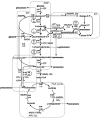Metabolic network analysis of Streptomyces tenebrarius, a Streptomyces species with an active entner-doudoroff pathway
- PMID: 15870314
- PMCID: PMC1087532
- DOI: 10.1128/AEM.71.5.2294-2302.2005
Metabolic network analysis of Streptomyces tenebrarius, a Streptomyces species with an active entner-doudoroff pathway
Abstract
Streptomyces tenebrarius is an industrially important microorganism, producing an antibiotic complex that mainly consists of the aminoglycosides apramycin, tobramycin carbamate, and kanamycin B carbamate. When S. tenebrarius is used for industrial tobramycin production, kanamycin B carbamate is an unwanted by-product. The two compounds differ only by one hydroxyl group, which is present in kanamycin carbamate but is reduced during biosynthesis of tobramycin. (13)C metabolic flux analysis was used for elucidating connections between the primary carbon metabolism and the composition of the antibiotic complex. Metabolic flux maps were constructed for the cells grown on minimal medium with glucose or with a glucose-glycerol mixture as the carbon source. The addition of glycerol, which is more reduced than glucose, led to a three-times-greater reduction of the kanamycin portion of the antibiotic complex. The labeling indicated an active Entner-Doudoroff (ED) pathway, which was previously considered to be nonfunctional in Streptomyces. The activity of the pentose phosphate (PP) pathway was low (10 to 20% of the glucose uptake rate). The fluxes through Embden-Meyerhof-Parnas (EMP) and ED pathways were almost evenly distributed during the exponential growth on glucose. During the transition from growth phase to production phase, a metabolic shift was observed, characterized by a decreased flux through the ED pathway and increased fluxes through the EMP and PP pathways. Higher specific NADH and NADPH production rates were calculated in the cultivation on glucose-glycerol, which was associated with a lower percentage of nonreduced antibiotic kanamycin B carbamate.
Figures








Similar articles
-
Large-Scale 13C flux profiling reveals conservation of the Entner-Doudoroff pathway as a glycolytic strategy among marine bacteria that use glucose.Appl Environ Microbiol. 2015 Apr;81(7):2408-22. doi: 10.1128/AEM.03157-14. Epub 2015 Jan 23. Appl Environ Microbiol. 2015. PMID: 25616803 Free PMC article.
-
Fructose metabolism in Chromohalobacter salexigens: interplay between the Embden-Meyerhof-Parnas and Entner-Doudoroff pathways.Microb Cell Fact. 2019 Aug 13;18(1):134. doi: 10.1186/s12934-019-1178-x. Microb Cell Fact. 2019. PMID: 31409414 Free PMC article.
-
Coexistence of the Entner-Doudoroff and Embden-Meyerhof-Parnas pathways enhances glucose consumption of ethanol-producing Corynebacterium glutamicum.Biotechnol Biofuels. 2021 Feb 16;14(1):45. doi: 10.1186/s13068-021-01876-3. Biotechnol Biofuels. 2021. PMID: 33593398 Free PMC article.
-
Embden-Meyerhof-Parnas and Entner-Doudoroff pathways in Thermoproteus tenax: metabolic parallelism or specific adaptation?Biochem Soc Trans. 2004 Apr;32(Pt 2):303-4. doi: 10.1042/bst0320303. Biochem Soc Trans. 2004. PMID: 15046594 Review.
-
[The unique Entner-Doudoroff (ED) glycolysis pathway of glucose in archaea--a review].Wei Sheng Wu Xue Bao. 2008 Aug;48(8):1126-31. Wei Sheng Wu Xue Bao. 2008. PMID: 18956766 Review. Chinese.
Cited by
-
Metabolic networks in motion: 13C-based flux analysis.Mol Syst Biol. 2006;2:62. doi: 10.1038/msb4100109. Epub 2006 Nov 14. Mol Syst Biol. 2006. PMID: 17102807 Free PMC article. Review.
-
Enhancement of ansamitocin P-3 production in Actinosynnema pretiosum by a synergistic effect of glycerol and glucose.J Ind Microbiol Biotechnol. 2014 Jan;41(1):143-52. doi: 10.1007/s10295-013-1374-3. Epub 2013 Oct 31. J Ind Microbiol Biotechnol. 2014. PMID: 24174216
-
Microbial cell factories for bio-based biodegradable plastics production.iScience. 2022 Oct 31;25(11):105462. doi: 10.1016/j.isci.2022.105462. eCollection 2022 Nov 18. iScience. 2022. PMID: 36405773 Free PMC article. Review.
-
Non-targeted metabolomics unravels a media-dependent prodiginines production pathway in Streptomyces coelicolor A3(2).PLoS One. 2018 Nov 28;13(11):e0207541. doi: 10.1371/journal.pone.0207541. eCollection 2018. PLoS One. 2018. PMID: 30485320 Free PMC article.
-
Intracellular Fate of Universally Labelled 13C Isotopic Tracers of Glucose and Xylose in Central Metabolic Pathways of Xanthomonas oryzae.Metabolites. 2018 Oct 15;8(4):66. doi: 10.3390/metabo8040066. Metabolites. 2018. PMID: 30326608 Free PMC article.
References
-
- Bai, N. J., M. R. Pai, P. S. Murthy, and T. A. Venkitasubramanian. 1976. Pathways of glucose catabolism in Mycobacterium smegmatis. Can. J. Microbiol. 22:1374-1380. - PubMed
-
- Budgen, N., and M. J. Danson. 1986. Metabolism of glucose via a modified Entner-Doudoroff pathway in the thermoacidophilic archaebacterium Thermoplasma acidophilum. FEBS Lett. 196:207-210.
-
- Christensen, B., and J. Nielsen. 1999. Isotopomer analysis using GC-MS. Metab. Eng. 1:282-290. - PubMed
-
- Christensen, B., and J. Nielsen. 2000. Metabolic network analysis of Penicillium chrysogenum using 13C-labeled glucose. Biotechnol. Bioeng. 68:652-659. - PubMed
Publication types
MeSH terms
Substances
Associated data
- Actions
LinkOut - more resources
Full Text Sources
Other Literature Sources
Miscellaneous

